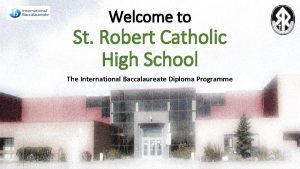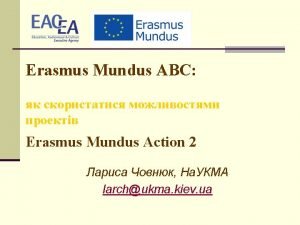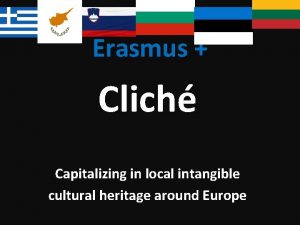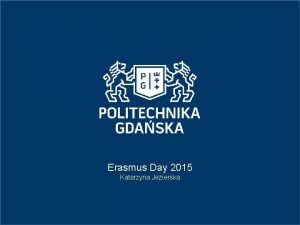Program Erasmus CLICH 2018 1 st High School



















- Slides: 19

Program: Erasmus+ CLICHÉ 2018 1 st High School of Livadia Perfecture of Viotia, Greece

Cliché INTANGIBLE CULTURAL HERITAGE FOR GREECE Category: Music and the Performing Arts Subject: Byzantine Music

Byzantine music "Speaking to one another in psalms and hymns and spiritual songs, singing and making melody in your heart to the Lord. " Ephesians (5: 19).

Byzantine music is the music of the Byzantine Empire composed to Greek texts as ceremonial, festival, or church music. Long thought to be only a further development of ancient Greek music, Byzantine music is now regarded as an independent musical culture. Characters of Byzantine Music

Origins and Early Christian Period The tradition of eastern liturgical chant, encompassing the Greek-speaking world, developed in the Byzantine Empire from the establishment of its capital, Constantinople, in 330 until its fall in 1453. It is undeniably of composite origin, drawing on the artistic and technical productions of the classical age, on Jewish music, and inspired by the monophonic vocal music that evolved in the early Christian cities of Alexandria, Antioch and Ephesus. Epheseus

Byzantine chant manuscripts date from the 9 th century, while lectionaries of biblical readings in Ekphonetic Notation (a primitive graphic system) begin about a century earlier and continue in use until the 12 th or 13 th century. Our knowledge of the older period is derived from Church service books Typika, patristic writings and medieval histories. Scattered examples of hymn texts from the early centuries of Greek Christianity still exist. Some of these employ the metrical schemes of classical Greek poetry; but the change of pronunciation had rendered those meters largely meaningless, and, except when classical forms were imitated, Byzantine hymns of the following centuries are prose-poetry, unrhymed verses of irregular length and accentual patterns. typika

The common term for a short hymn of one stanza, or one of a series of stanzas, is troparion). A famous example, whose existence is attested as early as the 4 th century, is the Vesper hymn, Phos Hilaron, "Gladsome Light“. PHOS HILARON (GENTLE LIGHT) O Gentle Light of the holy glory of the immortal, heavenly, holy, blessed Father, O Jesus Christ: Having come to the setting of the sun, having beheld the evening light, we praise the Father, the Son, and the Holy Spirit: God. Meet it is for Thee at all times to be hymned with reverent voices, O Son of God, Giver of life. Wherefore, the world doth glorify Thee.

Medieval Period Two concepts must be understood to appreciate fully the function of music in Byzantine worship: The first was the belief in the angelic transmission of sacred chant. The effect that this concept had on church music was threefold: first, it bred a highly conservative attitude to musical composition; secondly, it stabilized the melodic tradition of certain hymns; and thirdly, it continued, for a time, the anonymity of the composer.

The second, less permanent, concept was that of koinonia or "communion. " This was less permanent because, after the fourth century, when it was analyzed and integrated into a theological system, the bond and "oneness" that united the clergy and the faithful in liturgical worship was less potent. It is, however, one of the key ideas for understanding a number of realities for which we now have different names. With regard to musical performance, this concept of koinonia may be applied to the primitive use of the word choros. It referred, not to a separate group within the congregation entrusted with musical responsibilities, but to the congregation as a whole.

St. Romanos the Melodos The development of large scale hymnographic forms begins in the fifth century with the rise of the kontakion, a long and elaborate metrical sermon, reputedly of Syriac origin, which finds its acme in the work of St. Romanos the Melodos (sixth century). It comprises some 20 to 30 stanzas and was sung during the Morning Office (Orthros) in a simple and direct syllabic style (one note per syllable). The earliest musical versions, however, are "melismatic" (that is, many notes per syllable of text), and belong to the time of the ninth century and later when kontakia were reduced to the ptooimion (introductory verse) and first oikos (stanza).

In the second half of the seventh century, the kontakion was supplanted by a new type of hymn, the kanon, initiated by St. Andrew of Crete (ca. 660 -ca. 740) and developed by Saints John of Damascus and Kosmas of Jerusalem (both eighth century). Essentially, the kanon is an hymnodic complex comprised of nine odes which were originally attached to the nine Biblical canticles and to which they were related by means of corresponding poetic allusion or textual quotation. St. Kosmas of Jerusalem St. Andrew of Crete Sτ. John of Damascus

The nine heirmoi, however, are metrically dissimilar; consequently, an entire kanon comprises nine independent melodies (eight, when the second ode is omitted), which are united musically by the same mode and textually by references to the general theme of the liturgical occasion, and sometimes by an acrostic. Heirmoi in syllabic style are gathered in the Heirmologion, a bulky volume which first appeared in the middle of the tenth century and contains over a thousand model troparia arranged into an oktoechos (the eight-mode musical system). oktoechos

Another kind of hymn, important both for its number and for the variety of its liturgical use, is the sticheron. Their melodies preserved in the Sticherarion, are considerably more elaborate and varied than in the tradition of the Heirmologion. Sticherarion

Later Byzantine and Post-Byzantine Periods With the end of creative poetical composition, Byzantine chant entered its final period, devoted largely to the production of more elaborate musical settings of the traditional texts: either embellishments of the earlier simpler melodies, or original music in highly ornamental style. This was the work of the so-called Maistores, "masters, " of whom the most celebrated was St. John Koukouzeles (active c. 1300), compared in Byzantine writings to St. John of Damascus himself, as an innovator in the development of chant. St. John of Damascus St. John Koukouzeles

The multiplication of new settings and elaborations of the old continued in the centuries following the fall of Constantinople, until by the end of the eighteenth century the original musical repertory of the medieval musical manuscripts had been quite replaced by later compositions, and even the basic model system had undergone profound modification. Gospel Lectionary (Evangelistarion) 7 th century (British Library, Add. MS 5111)

Chrysanthos of Madytos (ca. 1770 -46), Gregory the Protopsaltes, and Chourmouzios the Archivist were responsible for a much needed reform of the notation of Greek ecclesiastical music. Essentially, this work consisted of a simplification of the Byzantine musical symbols which, by the early 19 th century, had become so complex and technical that only highly skilled chanters were able to interpret them correctly. Despite its numerous shortcomings the work of the three reformers is a landmark in the history of Greek Church music, since it introduced the system of neo-Byzantine music upon which are based the present-day chants of the Greek Orthodox Church. Chrysanthos of Madytos Gregory the Protopsaltes

An example of the simplification of the Byzantine musical symbols done by Chourmouzios

Cliché INTANGIBLE CULTURAL HERITAGE FOR GREECE Category: Music and the Performing Arts Subject: Byzantine Music

Students Loukas Spiropoulos Panagiota Plitsou Professors Argyro Charokopaki Sofia Katopodi
 2019 virginia tech high school programming contest
2019 virginia tech high school programming contest Ghid erasmus 2018
Ghid erasmus 2018 Proiecte erasmus+ 2016
Proiecte erasmus+ 2016 Dada la siguiente secuencia rusia 2018 rusia 2018
Dada la siguiente secuencia rusia 2018 rusia 2018 Language in french
Language in french Assvab occu find
Assvab occu find Asvab occu find
Asvab occu find High school financial planning program answer key
High school financial planning program answer key High school financial planning program answer key
High school financial planning program answer key Bell high school gifted program
Bell high school gifted program Interlake high school course catalog
Interlake high school course catalog Robbinsville high school program of studies
Robbinsville high school program of studies Robbinsville high school program of studies
Robbinsville high school program of studies North springs high school michael scott hanson
North springs high school michael scott hanson Interlake high school
Interlake high school Naviance radnor
Naviance radnor St robert catholic high school ib program boundary
St robert catholic high school ib program boundary Nefe high school financial planning program answers
Nefe high school financial planning program answers South forsyth high school ib program
South forsyth high school ib program Radnor high school hac
Radnor high school hac





































